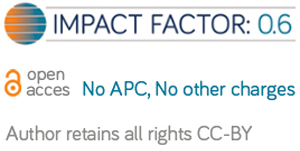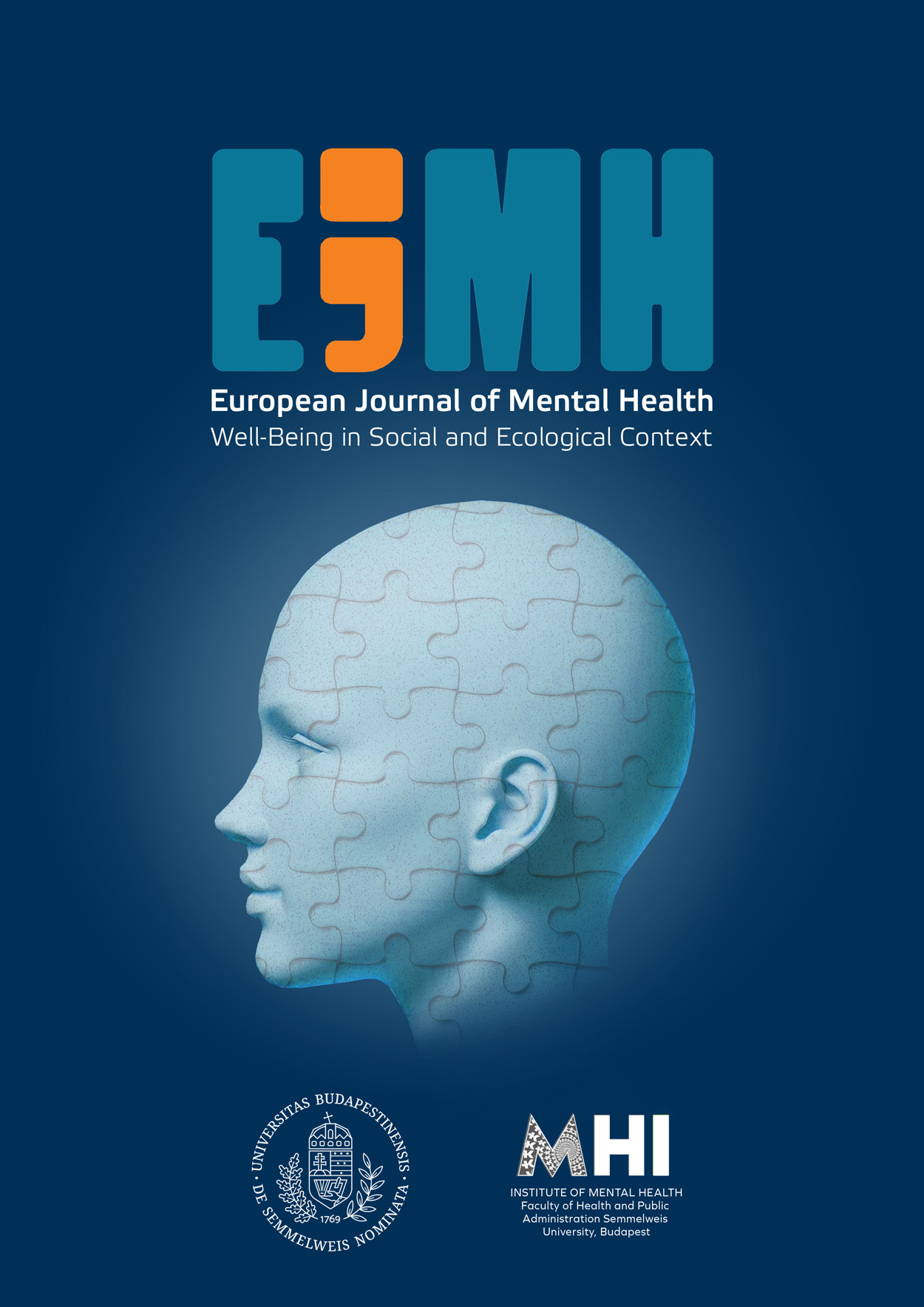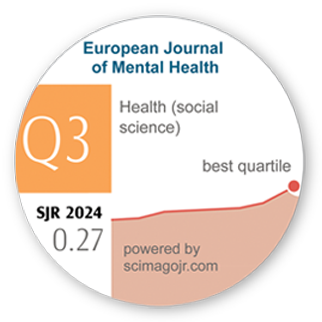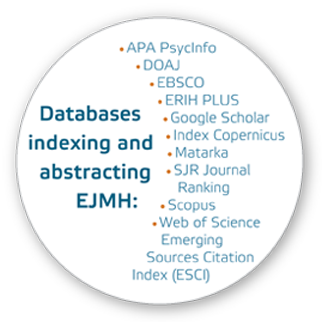The Effect of Adverse and Positive Childhood Experiences, Attachment, and Emotional Support on Adult Mental Health
DOI:
https://doi.org/10.5708/EJMH.19.2024.0031Keywords:
attachment anxiety, attachment avoidance, adverse and positive childhood experiences, self-rated mental health, self-rated emotional supportAbstract
Introduction: Adverse childhood experiences (ACEs) can contribute to significant health issues in adulthood.
Aims: The present study seeks to understand the role of attachment and positive childhood experiences (PCEs) in the association between ACEs, self-rated emotional support and mental health.
Methods: An online panel survey gathered data from 4,940 Slovenian adults aged 18 to 75. Simultaneous multiple regression path analysis (PROCESS) was used to test two moderation and mediation models.
Results: Results indicate that ACEs were weakly associated with higher rates of anxious attachment and reduced self-rated mental health. Anxious attachment mediated the relation between ACEs and self-rated emotional support and self-rated mental health. PCEs were weakly negatively associated with anxious and avoidant attachment and interacted with ACEs in their effect on emotional support in adulthood. The strongest associations were found in the negative pathways between the two attachment styles (anxious and avoidant), emotional support, and self-rated mental health.
Conclusions: These findings can guide (therapeutic) interventions for individuals with a history of child adversity: interventions could focus on addressing insecure attachment, involve a person’s social network as well as recognize and support the potential role of positive childhood experiences as protective factors.
References
Afifi, T. O., & MacMillan, H. L. (2011). Resilience following child maltreatment: A review of protective factors. Canadian Journal of Psychiatry, 56(5), 266–272.
https://doi.org/10.1177/070674371105600505
Ahmad, F., Jhajj, A. K., Stewart, D. E., Burghardt, M., & Bierman, A. S. (2014). Single item measures of self-rated mental health: A scoping review. BMC Health Services Research, 14, Article 398.
https://doi.org/10.1186/1472-6963-14-398
Ainsworth, M. D. S., Blehar, M. C., Waters, E., & Wall, S. (1978). Patterns of attachment: A psychological study of the strange situation. Erlbaum.
American Psychiatric Association. (2013). Diagnostic and statistical manual of mental disorders: DSM-5 (5th ed.). American Psychiatric Publishing.
https://doi.org/10.1176/appi.books.9780890425596
Anda, R. F., Felitti, V. J., Bremner, J. D., Walker, J. D., Whitfield, C., Perry, B. D., Dube, S. R., & Giles, W. H. (2006). The enduring effects of abuse and related adverse experiences in childhood: A convergence of evidence from neurobiology and epidemiology. European Archives of Psychiatry and Clinical Neuroscience, 256, 174–186.
https://doi.org/10.1007/s00406-005-0624-4
Anders, S. L., & Tucker, J. S. (2000). Adult attachment style, interpersonal communication competence, and social support. Personal Relationships, 7(4), 379–389.
https://doi.org/10.1111/j.1475-6811.2000.tb00023.x
Baer, J. C., & Martinez, C. D. (2006). Child maltreatment and insecure attachment: A meta-analysis. Journal of Reproductive and Infant Psychology, 24(3), 187–197.
https://doi.org/10.1080/02646830600821231
Bakermans-Kranenburg, M. J., van IJzendoorn, M. H., & Juffer, F. (2003). Less is more: Meta-analyses of sensitivity and attachment interventions in early childhood. Psychological Bulletin, 129(2), 195–215.
https://doi.org/10.1037/0033-2909.129.2.195
Bellis, M. A., Hardcastle, K., Ford, K., Hughes, K., Ashton, K., Quigg, Z., & Butler, N. (2017). Does continuous trusted adult support in childhood impart life-course resilience against adverse childhood experiences - A retrospective study on adult health-harming behaviours and mental well-being. BMC Psychiatry, 17, Article 110.
https://doi.org/10.1186/s12888-017-1260-z
Bethell, C., Jones, J., Gombojav, N., Linkenbach, J., & Sege, R. (2019). Positive childhood experiences and adult mental and relational health in a statewide sample: Associations across adverse childhood experiences levels. JAMA Pediatrics, 173(11), Article e193007.
https://doi.org/10.1001/jamapediatrics.2019.3007
Bifulco, A., Kwon, J., Jacobs, C., Moran, P. M., Bunn, A., & Beer, N. (2006). Adult attachment style as mediator between childhood neglect/abuse and adult depression and anxiety. Social Psychiatry and Psychiatric Epidemiology, 41, 796–805.
https://doi.org/10.1007/s00127-006-0101-z
Biggs, E. E., Carter, E. W., & Gustafson, J. (2017). Efficacy of peer support arrangements to increase peer interaction and AAC use. American Journal on Intellectual and Developmental Disabilities, 122(1), 25–48.
https://doi.org/10.1352/1944-7558-122.1.25
Blain, M. D., Thompson, J. M., & Whiffen, V. E. (1993). Attachment and perceived social support in late adolescence: The interaction between working models of self and others. Journal of Adolescent Research, 8(2), 226–241.
https://doi.org/10.1177/074355489382006
Brennan, K. A., Clark, C. L., & Shaver, P. R. (1998). Self-report measurement of adult attachment: An integrative overview. In J. A. Simpson & W. S. Rholes (Eds.), Attachment theory and close relationships (pp. 46–76). The Guilford Press.
Brenning, K. M., & Braet, C. (2013). The emotion regulation model of attachment: An emotion-specific approach. Personal Relationships, 20(1), 107–123.
https://doi.org/10.1111/j.1475-6811.2012.01399.x
Brothers, D. (2014). Traumatic attachments: Intergenerational trauma, dissociation, and the analytic relationship. International Journal of Psychoanalytic Self Psychology, 9(1), 3–15.
https://doi.org/10.1080/15551024.2014.857746
Caravaca-Sánchez, F, Fearn, N. E., Vidovic, K. R., & Vaughn, M. G. (2019). Female prisoners in Spain: Adverse childhood experiences, negative emotional states, and social support. Health & Social Work, 44(3), 157–166.
https://doi.org/10.1093/hsw/hlz013
Carver, C. S. (1997). Adult attachment and personality: Converging evidence and a new measure. Personality and Social Psychology Bulletin, 23(8), 865–883.
https://doi.org/10.1177/0146167297238007
Cassidy, J., & Berlin, L. J. (1994). The insecure/ambivalent pattern of attachment: Theory and research. Child Development, 65(4), 971–991.
https://doi.org/10.2307/1131298
Centers for Disease Control and Prevention. (n.d.). Behavioural Risk Factor Surveillance System ACE data.
https://www.cdc.gov/violenceprevention/aces/ace-brfss.html
Cheong, E. V., Sinnott, C., Dahly, D., Kearney, P. M. (2017). Adverse childhood experiences (ACEs) and later-life depression: Perceived social support as a potential protective factor. BMJ Open, 7, Article e013228.
https://doi.org/10.1136/bmjopen-2016-013228
Cicchetti, D., & Doyle, C. (2016). Child maltreatment, attachment and psychopathology: Mediating relations. World Psychiatry, 15(2), 89–90.
https://doi.org/10.1002/wps.20337
Coble, H. M., Gantt, D. L., & Mallinckrodt, B. (1996). Attachment, social competency, and the capacity to use social support. In G. R. Pierce, B. R. Sarason, & I. G. Sarason (Eds.), Handbook of Social Support and the Family (pp. 141–172). Springer.
https://doi.org/10.1007/978-1-4899-1388-3_7
Cohen, S., & Wills, T. A. (1985). Stress, social support, and the buffering hypothesis. Psychological Bulletin, 98(2), 310–357.
https://doi.org/10.1037/0033-2909.98.2.310
Collins, N. L., & Read, S. J. (1990). Adult attachment, working models, and relationship quality in dating couples. Journal of Personality and Social Psychology, 58(4), 644–663.
https://doi.org/10.1037/0022-3514.58.4.644
Colman, I., Kingsbury, M., Garad, Y., Zeng, Y., Naicker, K., Patten, S., Jones, P. B., Wild, T. C., & Thompson, A. H. (2016). Consistency in adult reporting of adverse childhood experiences. Psychological Medicine, 46(3), 543–549.
https://doi.org/10.1017/S0033291715002032
Corcoran, M., & McNulty, M. (2018). Examining the role of attachment in the relationship between childhood adversity, psychological distress and subjective well-being. Child Abuse & Neglect, 76, 297–309.
https://doi.org/10.1016/j.chiabu.2017.11.012
Crandall. A., Miller, J. R., Cheung, A., Novilla, L. K., Glade, R., Novilla, M. L. B., Magnusson, B. M., Leavitt, B. L., Barnes, M. D., & Hanson, C. L. (2019). ACEs and counter-ACEs: How positive and negative childhood experiences influence adult health. Child Abuse & Neglect, 96, Article 104089.
https://doi.org/10.1016/j.chiabu.2019.104089
Crouch, E., Probst, J. C., Radcliff, E., Bennett, K. J., & McKinney, S. H. (2019). Prevalence of adverse childhood experiences (ACEs) among US children. Child Abuse & Neglect, 92, 209–218.
https://doi.org/10.1016/j.chiabu.2019.04.010
Cutrona, C. E. (1990). Stress and social support – In search of optimal matching. Journal of Social and Clinical Psychology, 9(1), 3–14.
https://doi.org/10.1521/jscp.1990.9.1.3
Cutrona, C. E., & Russell, D. W. (1983). The provisions of social relationships and adaptation to stress. In W. H. Jones & D. Perlman (Eds.), Advances in Personal Relationships, Vol. 1 (pp. 37–67). JAI Press.
Daniel, S. I. F. (2006). Adult attachment patterns and individual psychotherapy: A review. Clinical Psychology Review, 26(8), 968–984.
https://doi.org/10.1016/j.cpr.2006.02.001
Dube, S. R., Felitti, V. J., Dong, M., Chapman, D. P., Giles, W. H., & Anda R. F. (2003). Childhood abuse, neglect, and household dysfunction and the risk of illicit drug use: The Adverse Childhood Experiences Study. Pediatrics, 111(3), 564-572.
https://doi.org/10.1542/peds.111.3.564
Edwards, V. J., Holden, G. W., Felitti, V. J., & Anda, R. F. (2003). Relationship between multiple forms of childhood maltreatment and adult mental health in community respondents: Results from the Adverse Childhood Experiences study. The American Journal of Psychiatry, 160(8), 1453–1460.
https://doi.org/10.1176/appi.ajp.160.8.1453
Erozkan, A. (2016). The link between types of attachment and childhood trauma. Universal Journal of Educational Research, 4(5), 1071–1079.
https://doi.org/10.13189/ujer.2016.040517
Felitti, V. J., Anda, R. F., Nordenberg, D., Williamson, D. F., Spitz, A. M., Edwards, V., Koss, M. P., & Marks, J. S. (1998): Relationship of childhood abuse and household dysfunction to many of the leading causes of death in adults: The adverse childhood experiences (ACE) study. American Journal of Preventive Medicine, 14(4), 245–258.
https://doi.org/10.1016/S0749-3797(98)00017-8
Florian, V., Mikulincer, M., & Bucholtz, I. (1995). Effects of adult attachment style on the perception and search for social support. The Journal of Psychology: Interdisciplinary and Applied, 129(6), 665–676.
https://doi.org/10.1080/00223980.1995.9914937
Haber, M. G. , Cohen, J. L., Lucas, T., & Baltes, B. B. (2007). The relationship between self-reported received and perceived social support: A meta-analytic review. American Journal of Community Psychology, 39(1–2), 133–144.
https://doi.org/10.1007/s10464-007-9100-9
Hankin, B. L. (2005). Childhood maltreatment and psychopathology: Prospective tests of attachment, cognitive vulnerability, and stress as mediating processes. Cognitive Therapy and Research, 29, 645–671.
https://doi.org/10.1007/s10608-005-9631-z
Hatton-Bowers, H., McPherran Lombardi, C., Kemp, B., Decker, K. B., Amini Virmani, E., Brophy-Herb, H. E., & Vallotton, C. D. (2023). Risks and resources for college students’ mental health: ACEs, attachment, and mindfulness. Journal of American College Health, 71(5), 1510–1521.
https://doi.org/10.1080/07448481.2021.1942007
Hayes, A. F. (2017). Introduction to mediation, moderation, and conditional process analysis: A regression-based approach (2nd ed.). Guilford Publications.
Hazan, C., & Shaver, P. (1987). Romantic love conceptualized as an attachment process. Journal of Personality and Social Psychology, 52(3), 511–524.
https://doi.org/10.1037/0022-3514.52.3.511
Hughes, D. (2017). Dyadic Developmental Psychotherapy (DDP): An attachment-focused family treatment for developmental trauma. Australian and New Zealand Journal of Family Therapy 38(4), 595–605.
https://doi.org/10.1002/anzf.1273
Hughes, K., Bellis, M. A., Hardcastle, K. A., Sethi, D., Butchart, A. , Mikton, C., Jones, L., & Dunne, M. P. (2017). The effect of multiple adverse childhood experiences on health: A systematic review and meta-analysis. The Lancet Public Health, 2(8), e356–e366.
https://doi.org/10.1016/S2468-2667(17)30118-4
Johnson, S. M., & Greenman, P. S. (2006). The path to a secure bond: Emotionally focused couple therapy. Journal of Clinical Psychology, 62(5), 597–609.
https://doi.org/10.1002/jclp.20251
Kobak, R. R., & Sceery, A. (1988). Attachment in late adolescence: Working models, affect regulation, and representations of self and others. Child Development, 59(1), 135–146.
https://doi.org/10.1111/j.1467-8624.1988.tb03201.x
Kuhar, M., & Zager Kocjan, G. (2021). Associations of adverse and positive childhood experiences with adult physical and mental health and risk behaviours in Slovenia. European Journal of Psychotraumatology, 12(1), Article 1924953.
https://doi.org/10.1080/20008198.2021.1924953
Lahousen, T., Unterrainer, H. F., & Kapfhammer, H. P. (2019). Psychobiology of attachment and trauma: Some general remarks from a clinical perspective. Frontieres in Psychiatry, 10, Article 914.
https://doi.org/10.3389/fpsyt.2019.00914
Levinson, D., & Kaplan, G. (2014). What does self-rated mental health represent. Journal of Public Health Research, 3(3), Article 287.
https://doi.org/10.4081/jphr.2014.287
Lin, H.-C., Yang, Y., Elliott, L., & Green, E. (2020). Individual differences in attachment anxiety shape the association between adverse childhood experiences and adult somatic symptoms. Child Abuse & Neglect, 101, Article 104325.
https://doi.org/10.1016/j.chiabu.2019.104325
Lyons-Ruth, K., Bureau, J.-F., Easterbrooks, M. A., Obsuth, I., Hennighausen, K., & Vulliez-Coady, L. (2013). Parsing the construct of maternal insensitivity: Distinct longitudinal pathways associated with early maternal withdrawal. Attachment & Human Development, 15(5–6), 562–582.
https://doi.org/10.1080/14616734.2013.841051
Main, M., & Hesse, E. (1990). Parents' unresolved traumatic experiences are related to infant disorganized attachment status: Is frightened and/or frightening parental behavior the linking mechanism? In M. T. Greenberg, D. Cicchetti, & E. M. Cummings (Eds.), Attachment in the preschool years: Theory, research, and intervention (pp. 161–182). The University of Chicago Press.
Main, M., & Solomon, J. (1990). Procedures for identifying infants as disorganized/ disoriented during the Ainsworth Strange Situation. In M. T. Greenberg, D. Cicchetti, & E. M. Cummings (Eds.), Attachment in the preschool years: Theory, research, and intervention (pp. 121–160). The University of Chicago Press.
Masten, A. S., & Cicchetti, D. (2016): Resilience in development: Progress and transformation. In D. Cicchetti (Ed.), Developmental psychopathology: Risk, resilience and intervention (pp. 271–333). John Wiley & Sons.
Mawani, F. N., & Gilmour, H. (2010). Validation of self-rated mental health. Health Reports, 21(3), 61–75.
McAlpine, D. D., McCreedy, E., & Alang, S. (2018). The meaning and predictive value of self-rated mental health among persons with a mental health problem. Journal of Health and Social Behavior, 59(2), 200–214.
https://doi.org/10.1177/0022146518755485
Mikulincer, M., & Florian, V. (1997). Are emotional and instrumental supportive interactions beneficial in times of stress? The impact of attachment style. Anxiety, Stress, and Coping, 10(2), 109–127.
https://doi.org/10.1080/10615809708249297
Mikulincer, M., Florian, V., & Weller, A. (1993). Attachment styles, coping strategies, and post-traumatic psychological distress: The impact of the Gulf War in Israel. Journal of Personality and Social Psychology, 64(5), 817–826.
https://doi.org/10.1037/0022-3514.64.5.817
Mikulincer, M., & Shaver, P. R. (2005). Attachment theory and emotions in close relationships: Exploring the attachment-related dynamics of emotional reactions to relational events, Personal Relationships, 12(2), 149–168.
https://doi.org/10.1111/j.1350-4126.2005.00108.x
Mikulincer, M., & Shaver, P. R. (2007). Attachment in adulthood: Structure, dynamics, and change. The Guilford Press.
Mikulincer, M., & Shaver, P. R. (2012). An attachment perspective on psychopathology. World Psychiatry, 11(1), 11–15.
https://doi.org/10.1016/j.wpsyc.2012.01.003
Muller, R. T. (2009). Trauma and dismissing (avoidant) attachment: Intervention strategies in individual psychotherapy. Psychotherapy Theory, Research, Practice, Training, 46(1), 68–81.
https://doi.org/10.1037/a0015135
Muller, R. T., Thornback, K., & Bedi, R. (2012). Attachment as a mediator between childhood maltreatment and adult symptomatology. Journal of Family Violence, 27, 243–255.
https://doi.org/10.1007/s10896-012-9417-5
Nguyen, C. P., Wong, Y. J., Juang, L. P., & Park, I. J. K. (2015). Pathways among Asian Americans’ family ethnic socialization, ethnic identity, and psychological well-being: A multigroup mediation model. Asian American Journal of Psychology, 6(3), 273–280.
https://doi.org/10.1037/aap0000026
Norman, G. (2010). Likert scales, levels of measurement and the “laws” of statistics. Advances in Health Sciences Education, 15, 625–632.
https://doi.org/10.1007/s10459-010-9222-y
Ognibene, T. C., & Collins, N. L. (1998). Adult attachment styles, perceived social support and coping strategies. Journal of Social and Personal Relationships, 15(3), 323–345.
https://doi.org/10.1177/0265407598153002
Oshri, A, Sutton, T. E., Clay-Warner, J., & Miller, J. D. (2015). Child maltreatment types and risk behaviors: Associations with attachment style and emotion regulation dimensions. Personality and Individual Differences, 73, 127–133.
https://doi.org/10.1016/j.paid.2014.09.015
Petruccelli, K., Davis, J., & Berman, T. (2019). Adverse childhood experiences and associated health outcomes: A systematic review and meta-analysis. Child Abuse & Neglect, 97, Article 104127.
https://doi.org/10.1016/j.chiabu.2019.104127
Priel, B., & Shamai, D. (1995). Attachment style and perceived social support: Effects on affect regulation. Personality and Individual Differences, 19(2), 235–241.
https://doi.org/10.1016/0191-8869(95)91936-T
Rains, M., & McClinn, K. (2013). Resilience questionnaire.
https://csw.osu.edu/wp-content/uploads/2019/05/Garcia-Ashley-Handout.pdf
Riggs, S. A., Paulson, A., Tunnell, E., Sahl, G., Atkinson, H., Ross, C. A. (2007). Attachment, personality, and psychopathology among adult inpatients: Self-reported romantic attachment style versus Adult Attachment Interview states of mind. Development and Psychopathology, 19(1), 263–291.
https://doi.org/10.1017/S0954579407070149
Runtz, M. G., & Schallow, J. R. (1997). Social support and coping strategies as mediators of adult adjustment following child maltreatment. Child Abuse & Neglect, 21(2), 211–226.
https://doi.org/10.1016/S0145-2134(96)00147-0
Sarason, B. R., Pierce, G. R., Shearin, E. N., Sarason, I. G., Waltz, J. A., & Poppe. L. (1991). Perceived social support and working models of self and others. Journal of Personality and Social Psychology, 60(2), 273–287.
https://doi.org/10.1037/0022-3514.60.2.273
Schimmenti, A., & Bifulco, A. (2015). Linking lack of care in childhood to anxiety disorders in emerging adulthood: The role of attachment styles. Child and Adolescent Mental Health, 20(1), 41–48.
https://doi.org/10.1111/camh.12051
Schore, J. R., & Schore, A. N. (2008). Modern attachment theory: The central role of affect regulation in development and treatment. Clinical Social Work Journal, 36(1), 9–20.
https://doi.org/10.1007/s10615-007-0111-7
Schüssler-Fiorenza Rose, S. M., Eslinger, J. G., Zimmerman, L., Scaccia, J., Lai, B. S., Lewis, C., & Alisic, E. (2016). Adverse childhood experiences, support, and the perception of ability to work in adults with disability. PLoS ONE, 11(7), Article e0157726.
https://doi.org/10.1371/journal.pone.0157726
Sirois, F. M., Millings, A., & Hirsch, J. K. (2016). Insecure attachment orientation and well-being in emerging adults: The roles of perceived social support and fatigue. Personality and Individual Differences, 101, 318–321.
https://doi.org/10.1016/j.paid.2016.06.026
Sperry, D. M., & Widom, C. S. (2013). Child abuse and neglect, social support, and psychopathology in adulthood: A prospective investigation. Child Abuse & Neglect, 37(6), 415–425.
https://doi.org/10.1016/j.chiabu.2013.02.006
Statistical Office of the Republic of Slovenia SURS (2018). SI-STAT Data Portal.
https://pxweb.stat.si/SiStat/sl
Sullivan, G. M., & Artino, A. R. (2013). Analyzing and interpreting data from Likert-type scales. Journal of Graduate Medical Education, 5(4), 541–542.
https://doi.org/10.4300/JGME-5-4-18
Švab, A., Rener, T., & Kuhar, M. (2012). Behind and beyond Hajnal’s line: Families and family life in Slovenia. Journal of Comparative Family Studies, 43(3), 419–437.
https://doi.org/10.3138/jcfs.43.3.419
Taunton, M., McGrath, L., Broberg, C., Levy, S., Kovacs. A. H., & Khan, A. (2021). Adverse childhood experience, attachment style, and quality of life in adult congenital heart disease. International Journal of Cardiology Congenital Heart Disease, 5, Article 100217.
https://doi.org/10.1016/j.ijcchd.2021.100217
Thornberry, T. P., Henry, K. L., Smith, C. A., Ireland, T. O., Greenman, S. J. & Lee, R. D. (2013). Breaking the cycle of maltreatment: The role of safe, stable, and nurturing relationships. Journal of Adolescent Health, 53(4), S25–S31.
https://doi.org/10.1016/j.jadohealth.2013.04.019
United Nations (2015). Transforming our world: The 2030 agenda for sustainable development.
https://sdgs.un.org/2030agenda
van der Kolk, B. A., Roth, S., Pelcovitz, D., Sunday, S., & Spinazzola, J. (2005). Disorders of extreme stress: The empirical foundation of a complex adaptation to trauma. Journal of Traumatic Stress, 18(5), 389–399.
https://doi.org/10.1002/jts.20047
Wallace, J. L., & Vaux, A. (1993). Social support network orientation: The role of adult attachment style. Journal of Social and Clinical Psychology, 12(3), 354–365.
https://doi.org/10.1521/jscp.1993.12.3.354
Widom, C. S., Czaja, S., Kozakowski, S., & Chauhan, P. (2018). Does adult attachment style mediate the relationship between childhood maltreatment and mental and physical health outcomes? Child Abuse & Neglect, 76, 533–545.
https://doi.org/10.1016/j.chiabu.2017.05.002
World Health Organization. (2022). Mental health.
https://www.who.int/news-room/fact-sheets/detail/mental-health-strengthening-our-response






